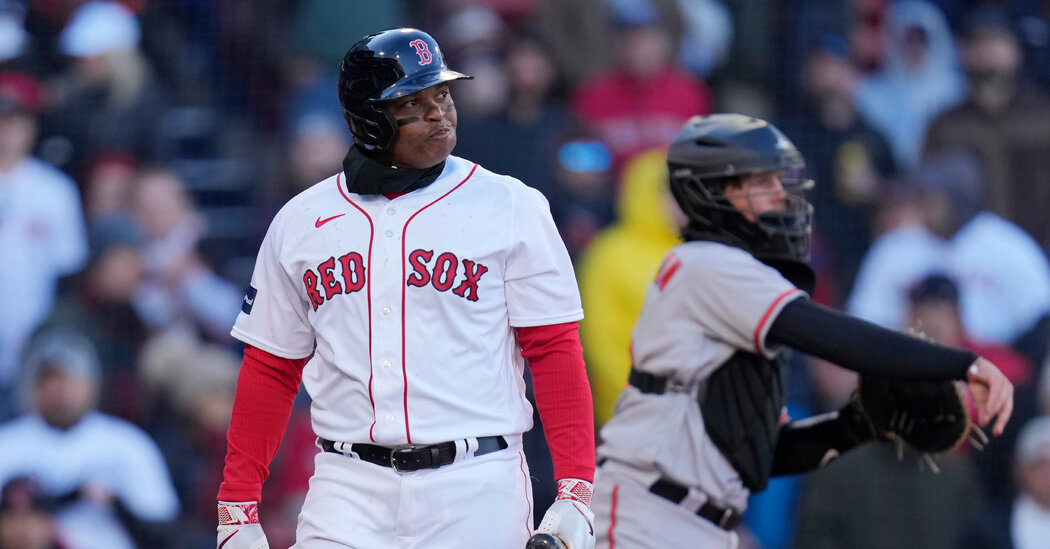
In the first inning of his major league career, 58 years ago at Fenway Park in Boston, Jim Palmer struck out Tony Conigliaro on a high fastball. On Thursday, from the Baltimore Orioles’ broadcast booth, Palmer looked down at the same mound and saw a pitcher get a third strike without even throwing a pitch.
In the eighth inning on opening day, the Orioles’ Bryan Baker fanned the Red Sox’ Rafael Devers for the first strikeout in baseball history to end on a pitch-clock violation. Baker had come set with a 1-2 count, but Devers was not looking at him when the pitch clock — new for 2023 — reached the eight-second mark.
Strike three.
“It kind of left an empty feeling, and I’m not even for the Red Sox,” said Palmer, a Hall of Fame pitcher for the Orioles. “I mean, you’re in the stands, you paid all that money and your best hitter is called out because he’s looking at the pitcher a second or two too late. I understand why we’re doing it, but boy, it was disappointing.”
Baseball is doing it because the modern game had gotten longer and longer, with less and less action. In the very early going of the season, a batch of changes — a pitch clock, a ban on the infield shift, bigger bases and limits on pickoff throws — is accomplishing what Major League Baseball hoped: a return of the game to its natural rhythms.
Through 35 total games over three days, the games are faster, more batted balls are turning into hits and stolen bases are up. The average game time was 2 hours 41 minutes — 23 minutes faster than the average nine-inning game last season. Batters are hitting .310 on balls in play, up from .292 last season. Stolen base attempts have risen a bit (to 1.6 per game from 1.3), but the success rate has jumped to 87.5 percent from 74.
“It’s a different game — you have to go on instinct and your brain has to move like this,” said the Mets’ Mark Canha, snapping his fingers in Miami on Saturday after a 2 hour 9 minute game, the Mets’ quickest in nearly four years. “You’re going to look back at 2023 and say the game changed in a big way.”
What to Know About M.L.B.’s New Rules
The new rules, collectively, mark the most significant changes to baseball in generations. In 1969, M.L.B. shaved five inches off the height of the mound, lowering it to 10 inches. Four years later — with offense still sluggish — the American League introduced the designated hitter to bat for the pitcher.
In recent years, as pace of play came to be viewed as a critical issue to baseball’s long-term appeal, the league tried smaller measures to move games along. Mound visits were limited, pitching changes were restricted, intentional walks were streamlined — but nothing seemed to work.
“I remember back when they implemented the rule that you couldn’t step out of the batter’s box,” said Nelson Cruz, the San Diego Padres’ designated hitter, referring to a 2015 edict imploring hitters to keep one foot in the batter’s box between pitches. “Everyone was complaining. And then they ended it.”
This time — in Commissioner Rob Manfred’s ninth season on the job — the league is finally serious. The new rules were tested on minor leaguers in recent seasons, and all were in play for exhibition games at spring training this year. There are no surprises anymore.
“I think that we’ll make the adjustments, and I do think it’ll be a good game,” said Cleveland Guardians Manager Terry Francona during spring training. “I just think there’s going to be growing pains, because these are bigger changes than we’ve ever had before and you’re asking people to do something they’ve never done. So it’s going to take a minute to do that.”
Sure enough, in the eighth inning of Cleveland’s opener in Seattle, reliever James Karinchak came undone after a pitch-clock violation. Karinchak, who is notoriously fidgety on the mound, was charged with a ball on an 0-2 count to the Mariners’ J.P. Crawford. Karinchak then fired his next pitch to the backstop, and after a walk, an out and a hit batter, he gave up a three-run homer for the only runs of the game in his team’s 3-0 loss.
“He has a routine, a very lengthy routine,” Mariners manager Scott Servais told reporters later. “He’s had to try to make adjustments with that — the things he does with the ball, flipping it and everything else. He was a little bit out of whack.”
The first pitcher called for a violation on Thursday, the Chicago Cubs’ Marcus Stroman, managed six shutout innings in a victory over the Milwaukee Brewers. But Stroman acknowledged that the rules will be challenging.
“I do feel super rushed at times,” Stroman told reporters later. “Even between innings. I’m running out there very early to warm up in between. A foul comes up and you don’t even have time to rub the ball up. And I’m a big breather. Sometimes I’m not able to catch my breath and find my proper breathing that I do before pre-pitch.”
Like Stroman, the Mets’ David Robertson could live without the clock. But also like Stroman, Robertson managed just fine with it, retiring the Marlins in order for a save on opening day.
“I felt like I was at warp speed,” said Robertson, adding that he, too, had trouble catching his breath. “That’s a lot of games to play at that pace.”
The schedule, indeed, is relentless, with 162 games in 186 days. Yet for decades, the length of games remained stable. In Palmer’s rookie season, the average nine-inning game was 2 hours 31 minutes. When he retired 19 years later, in 1984, it was 2:35.
“We used to start games at 8:05 and I was always home to see Johnny Carson, and I lived about 20, 25 minutes from the ballpark,” Palmer said. “That was kind of my guideline. I never missed his monologue at 11:30.”
The Orioles’ game against the Red Sox still took a while on Thursday; with a combined 26 hits, 12 walks and 12 pitchers, it lasted 3 hours 10 minutes. But it also featured more action than usual, especially on the bases. The Orioles had five stolen bases — all without a throw — and swiped four more on Saturday.
Adjusting to a more aggressive running game, Mets Manager Buck Showalter said, will come at a cost to pitchers who hurry their deliveries.
“There’s usually a point and counterpoint to everything that comes in,” Showalter said, noting that a Marlins pitcher had quickened his time to the plate with the speedy Starling Marte on first base. “You can keep him from going if you’re that fast, but you’re giving up a lot to the hitter.”
All along, M.L.B. has believed that today’s players are skilled enough to quickly modify their habits. In the minors, violations declined sharply in very little time; there were 1.73 pitch-clock violations per game in week two, and .73 in week five.
So far in the majors, there have been 33 violations in the first 35 games (24 by pitchers, eight by hitters and one by a catcher) for an average of .94 per game. The violations are a part of baseball now, but accounting for them on a scorecard is up for interpretation.
“Kevin Brown, our play-by-play guy, said, ‘Do we put a backwards K or do we put a regular K?’” Palmer said, referring to that first phantom strikeout. “I said, ‘How about a sideways K? Because that’s the way Devers feels right now.’”
James Wagner and Scott Miller contributed reporting.

